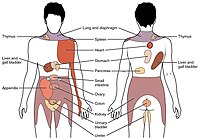
Photo from wikipedia
Abstract Background and aims Evaluating the degree to which pain has become chronic beyond mere duration poses several problems. The IASP Pain Taxonomy Axis IV employs intensity and duration combined… Click to show full abstract
Abstract Background and aims Evaluating the degree to which pain has become chronic beyond mere duration poses several problems. The IASP Pain Taxonomy Axis IV employs intensity and duration combined to nine ordered categories. The Chronic Pain Grade links intensity and disability, but only the latter contributes to higher grades. The Mainz Pain Staging System includes temporal and spatial aspects, medication and health care utilization. Their interrelations, scale properties and construct validity are not always known or debatable. The study challenges the generality and homogeneity of the chronicity construct of musculoskeletal pain aiming at necessary and sufficient sub-constructs identified by separable marker clusters. We show chronicity to vary in content and structure with severity and duration and between different populations. This raises the question of validity conditions of general chronicity indices and requires further work on adequate chronicity measures. Methods Diagnostic entrance data of 185 patients with chronic regional vs. widespread musculoskeletal pain (unspecific back pain, fibromyalgia) from regional pain clinics and 170 active employees in a nationwide prevention program were included in a retrospective cross-sectional analysis of the combined marker sets of the three chronicity indices above. The samples of patients and employees provided intensity, duration and disability degrees over the whole range of the assumed chronicity. Intensity-duration relations were quantified by correlations and frequency distributions of successive duration classes. The dimensional structure of pain and chronicity variables was assessed by factor and cluster analyses. Results Pain intensity distributions showed inhomogeneous courses from short to long durations – lowest intensities predominating at longer durations in patients and at shorter in employees. Moreover, pain intensity and duration related nonlinearly to Chronic Pain Grade and Mainz Pain Stage and differently in patients compared to employees, and these indices correlated only moderately to each other. Factor and cluster analyses revealed different dimensions and clusters of chronicity markers for patients and employees. In the former, three dimensions with four clusters were identified with clinical characteristics (intensity, temporal and spatial aspects) separated from direct consequences (disability/interference with activities, medication usage) and chronic development (duration, healthcare utilization). In employees, only two dimensions with three clusters were obtained and clinical pain characteristics clustered with direct consequences both separated from chronic development. Similar differences were shown between unspecific back pain and fibromyalgia but were less well defined. Conclusions There appears to be no coherent “chronicity” entity over the entire range of severity and duration for all pain populations with different clinical pictures and social contexts. Statements about chronicity must be differentiated with respect to those aspects relative to patient career. Implications General indices do not capture the complex and changing composition of chronicity. There is evidence for at least three weakly coupled core domains of chronicity, i.e. the primary clinical characteristics, the direct consequences of current interference with activities, and aspects of the patient history. Hence, multivariate assessment is recommended. The particular syndrome, the diagnostic context and the population under investigation should likewise be considered.
Journal Title: Scandinavian Journal of Pain
Year Published: 2018
Link to full text (if available)
Share on Social Media: Sign Up to like & get
recommendations!